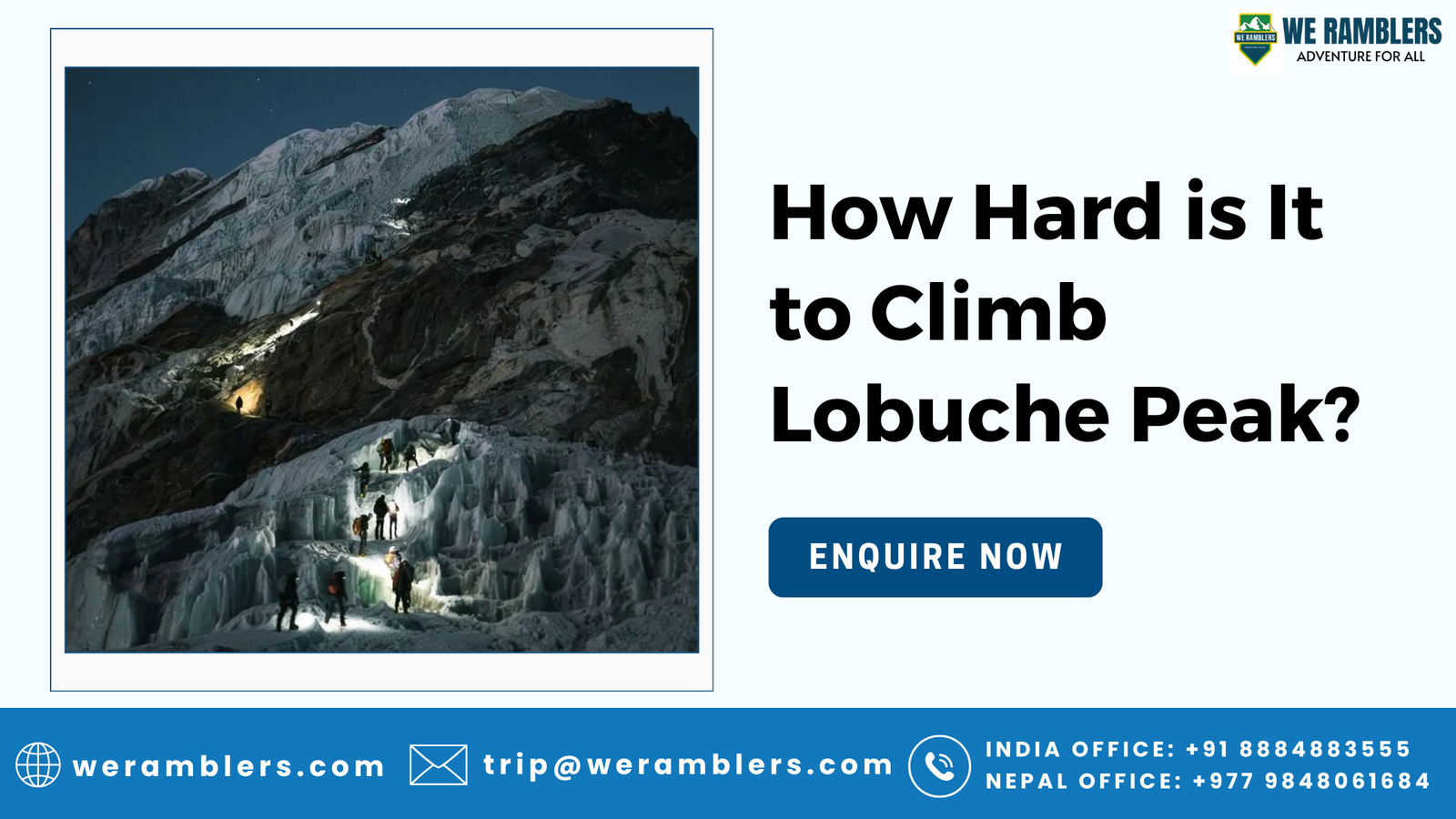How Hard Is It to Climb Lobuche Peak?
For many adventure seekers dreaming of conquering the Himalayas, one question often comes up: “How hard is it to climb Lobuche Peak?” This majestic trekking peak in Nepal offers the perfect mix of high-altitude adventure and technical challenge, making it a favorite among trekkers aiming to progress from classic treks to true mountaineering experiences.
Located near Everest Base Camp, Lobuche Peak rewards climbers with breathtaking views of Everest, Lhotse, Nuptse, and Ama Dablam. But before taking on this climb, understanding the physical demands, technical challenges, and preparation required is essential. So, let’s explore just how hard it is to climb Lobuche Peak and what makes it one of Nepal’s most rewarding adventures.
Overview: How Hard Is It to Climb Lobuche Peak?
- Lobuche East (6,119m) is the most commonly climbed of the two Lobuche peaks (East and West).
- It is classified as a “trekking peak” by the Nepal Mountaineering Association (NMA), but it involves moderate technical climbing.
- The climb includes glacier travel, steep ice slopes, and fixed rope ascents that require the use of crampons, ice axes, and harnesses.
- Climbers should be in good physical condition with prior high-altitude trekking or basic mountaineering experience.
While not as technically demanding as Island Peak, Lobuche Peak is considered tougher than Mera Peak because of its steep slopes and complex terrain near the summit.
Understanding Lobuche Peak Climb Difficulty
Lobuche Peak stands proudly in the Khumbu region, just a few kilometers southwest of Everest Base Camp. It’s divided into two main summits — Lobuche East (6,119m) and Lobuche West (6,145m). Most climbers attempt Lobuche East, as Lobuche West is a separate expedition requiring additional permits and technical skill.
The ascent to Lobuche East starts with a classic trek through the Everest Base Camp trail, passing through Namche Bazaar, Tengboche, Dingboche, and Lobuche village. This part of the journey helps with acclimatization and builds stamina for the climb.
From Lobuche High Camp (around 5,400m), climbers face a steep, icy climb that tests endurance, technical ability, and mental strength. The route involves:
- Steep snow and ice slopes (up to 45–50 degrees incline).
- Fixed rope ascents for the final summit push.
- Exposure to altitude and potential weather changes.
Key Factors That Make Lobuche Peak Challenging
High Altitude:
The summit rises above 6,100 meters, where oxygen levels drop significantly. Proper acclimatization is crucial to avoid altitude sickness.
Technical Aspects:
While categorized as a trekking peak, Lobuche requires using mountaineering equipment — crampons, ice axe, and jumar for fixed ropes. The final push to the summit is physically intense and technically demanding.
Weather Conditions:
Harsh winds, freezing temperatures, and sudden weather shifts can make the climb unpredictable. Optimal seasons (spring and autumn) are crucial for safety.
Physical Fitness:
Climbers should have excellent cardiovascular endurance, leg strength, and stamina. Daily trekking for 6–8 hours and climbing on ice slopes demands strong physical conditioning.
Mental Preparedness:
Beyond physical effort, climbers face mental challenges — long days, freezing conditions, and the mental pressure of high-altitude climbing.
Why Trekkers Ask “How Hard Is It to Climb Lobuche Peak?”
People often ask this question because:
- They’re transitioning from trekking to mountaineering.
- They want to assess if Lobuche is suitable before attempting tougher climbs like Island Peak or Ama Dablam.
- They’re curious about the technical difficulty, not just the altitude.
- They want to plan training and preparation before booking the expedition.
The answer depends on your prior experience; for seasoned trekkers, Lobuche Peak is a moderately challenging adventure. For beginners, it’s a serious introduction to Himalayan climbing that demands preparation and professional guidance.
Why Choose We Ramblers for Lobuche Peak Climb?
At We Ramblers, we’ve been guiding adventurers through the Himalayas for years, offering expertly organized expeditions to Lobuche Peak and beyond. With our team, safety, comfort, and success are always the top priorities.
Why choose We Ramblers:
- Professional Guides: Our certified Sherpa and climbing guides are experts in technical ascents and altitude management.
- Safety First: We provide full safety equipment, acclimatization schedules, and medical support throughout the journey.
- Custom Itineraries: Flexible plans tailored to your experience level and preferences.
- All-Inclusive Support: From permits and logistics to meals and gear, everything is taken care of.
- Contact: Connect with us to explore detailed itineraries.
Final Thoughts
So, how hard is it to climb Lobuche Peak? The climb is moderately difficult — challenging enough to test your endurance and technical ability, yet achievable with proper preparation and expert guidance. With stunning Himalayan scenery and a rewarding sense of accomplishment, Lobuche Peak is an ideal choice for adventure enthusiasts ready to push their limits.
With We Ramblers, you can take on this Himalayan challenge confidently, supported by professionals who prioritize your safety, success, and unforgettable experience every step of the way.
FAQs: How Hard Is It to Climb Lobuche Peak?
Is Lobuche Peak harder than Island Peak?
Yes, Lobuche Peak is slightly more technical with steeper sections and more exposure, though both are challenging climbs.
Do I need mountaineering experience for Lobuche Peak?
Basic mountaineering or prior high-altitude trekking experience is recommended, but We Ramblers provides pre-climb training.
How long does it take to climb Lobuche Peak?
Typically, the climb takes 16–18 days, including acclimatization and trekking.
What is the best time to climb Lobuche Peak?
Spring (March–May) and autumn (September–November) are the best seasons for stable weather and clear views.
Is Lobuche Peak suitable for beginners?
It’s ideal for trekkers looking to step into mountaineering, but physical fitness and mental preparation are essential.





